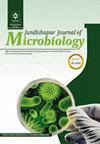Evaluation of the Effects of Dielectric Barrier Discharge Plasma on Candida albicans Strains: An in vitro Study
IF 0.5
4区 医学
Q4 MICROBIOLOGY
引用次数: 0
Abstract
Background: Antifungal resistance is increasing, posing a challenge for treating candidiasis. Cold atmospheric plasma (CAP) is a potential alternative, but its association with traditional antifungals is poorly understood. Objectives: This study aims to evaluate the effects of dielectric barrier discharge (DBD) plasma on Candida albicans. Methods: In this in vitro study, C. albicans strains were irradiated with DBD plasma for 5, 10, and 15 minutes, both with and without nystatin. The number of colonies was counted, and the MTT method assessed Candida's survival. Data were analyzed with SPSS26. Results: This study showed that in both experimental groups, with and without nystatin, the lowest C. albicans cell viability was observed following a 10 minute DBD exposure within the groups subjected to plasma treatment (P < 0.001). The positive control group (nystatin without plasma exposure) exhibited a diminished count of viable cells in comparison to the group with 10 minute plasma irradiation without nystatin (P < 0.001). The 10 and 15 minute DBD plasma exposures, along with their positive control counterparts, demonstrated a statistically significant reduction in colony count compared to the 5 minute DBD exposure and the negative control groups (P < 0.001). Conclusions: Nystatin was more effective than DBD plasma irradiation in reducing C. albicans cell viability. When used in combination, 10 minute DBD plasma irradiation with nystatin was more effective than 5 or 15 minute irradiation times in reducing the survival rate of C. albicans.评估介质阻挡放电等离子体对白色念珠菌菌株的影响:体外研究
背景:抗真菌耐药性正在增加,给治疗念珠菌病带来了挑战。冷大气等离子体(CAP)是一种潜在的替代疗法,但人们对它与传统抗真菌药物之间的关系知之甚少。研究目的本研究旨在评估介质阻挡放电(DBD)等离子体对白色念珠菌的影响。方法:在这项体外研究中,用 DBD 等离子体照射白色念珠菌菌株 5、10 和 15 分钟,同时使用或不使用奈司他丁。计数菌落数量,并用 MTT 法评估白色念珠菌的存活率。数据用 SPSS26 进行分析。结果研究结果表明,在两个实验组中,无论是使用还是不使用硝司他丁,在暴露于 DBD 10 分钟后,观察到血浆处理组的白色念珠菌细胞存活率最低(P < 0.001)。阳性对照组(未暴露于等离子体的硝司他丁)与经过 10 分钟等离子体照射但未暴露于硝司他丁的组相比,存活细胞数量减少(P < 0.001)。与 5 分钟 DBD 照射组和阴性对照组相比,10 分钟和 15 分钟 DBD 血浆照射组及其阳性对照组的菌落数量在统计学上显著减少(P < 0.001)。结论:在降低白僵菌细胞活力方面,硝司他丁比 DBD 等离子照射更有效。在降低白僵菌存活率方面,10 分钟 DBD 等离子辐照与硝司他丁联合使用比 5 分钟或 15 分钟辐照更有效。
本文章由计算机程序翻译,如有差异,请以英文原文为准。
求助全文
约1分钟内获得全文
求助全文
来源期刊

Jundishapur Journal of Microbiology
MICROBIOLOGY-
CiteScore
1.30
自引率
0.00%
发文量
56
审稿时长
6-12 weeks
期刊介绍:
Jundishapur Journal of Microbiology, (JJM) is the official scientific Monthly publication of Ahvaz Jundishapur University of Medical Sciences. JJM is dedicated to the publication of manuscripts on topics concerning all aspects of microbiology. The topics include medical, veterinary and environmental microbiology, molecular investigations and infectious diseases. Aspects of immunology and epidemiology of infectious diseases are also considered.
 求助内容:
求助内容: 应助结果提醒方式:
应助结果提醒方式:


